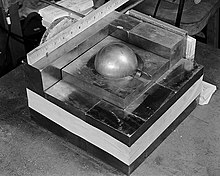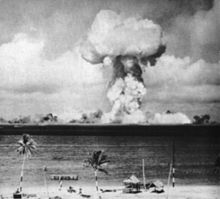Demon core
From Wikipedia, the free encyclopedia
The demon core was a 6.2-kilogram (14 lb; 1 st), 3.5-inch-diameter (89 mm) subcritical mass of plutonium which went briefly critical in two separate accidents at the Los Alamos laboratory in 1945 and 1946. Each incident resulted in the acute radiation poisoning and subsequent death of a scientist. After these incidents the spherical plutonium pit was referred to as the "demon core."
The demon core was used in the first atomic bomb test to be conducted after World War II, five weeks after the second fatal accident. It performed normally and with the same explosive yield as the next core used in this set of two tests.
Contents


A re-creation of the 1945 incident. The sphere of plutonium is surrounded by neutron-reflecting tungsten carbide blocks.
On August 21, 1945, the plutonium core produced a burst of neutron radiation that led to Harry Daghlian's death. Daghlian, a physicist, made a mistake while working alone performing neutron reflection experiments on the core. The core was placed within a stack of neutron-reflective tungsten carbide bricks and the addition of each brick moved the assembly closer to criticality. While attempting to stack another brick around the assembly, Daghlian accidentally dropped it onto the core and thereby caused the core to go critical, a self-sustaining chain reaction. Despite quick action in moving the brick off the assembly, Daghlian received a fatal dose of radiation. He died 25 days later from acute radiation poisoning.[1]
Another person who was in the lab at the time of the accident—Private Robert J. Hemmerly, a Special Engineer Detachment (SED) guard—received an exposure of approximately 31 roentgens (0.31 Gy) of soft X-rays (80 kV equivalent) and less than 1 roentgen (0.01 Gy) of gamma rays. Hemmerly died in 1978 (33 years after the accident) from acute myelogenous leukemia at the age of 62.[2]
From Wikipedia, the free encyclopedia
The demon core was a 6.2-kilogram (14 lb; 1 st), 3.5-inch-diameter (89 mm) subcritical mass of plutonium which went briefly critical in two separate accidents at the Los Alamos laboratory in 1945 and 1946. Each incident resulted in the acute radiation poisoning and subsequent death of a scientist. After these incidents the spherical plutonium pit was referred to as the "demon core."
The demon core was used in the first atomic bomb test to be conducted after World War II, five weeks after the second fatal accident. It performed normally and with the same explosive yield as the next core used in this set of two tests.
Contents
- 1 First incident
- 2 Second incident
- 3 Demon core in use
- 4 Cultural references
- 5 See also
- 6 References
- 7 External links


A re-creation of the 1945 incident. The sphere of plutonium is surrounded by neutron-reflecting tungsten carbide blocks.
On August 21, 1945, the plutonium core produced a burst of neutron radiation that led to Harry Daghlian's death. Daghlian, a physicist, made a mistake while working alone performing neutron reflection experiments on the core. The core was placed within a stack of neutron-reflective tungsten carbide bricks and the addition of each brick moved the assembly closer to criticality. While attempting to stack another brick around the assembly, Daghlian accidentally dropped it onto the core and thereby caused the core to go critical, a self-sustaining chain reaction. Despite quick action in moving the brick off the assembly, Daghlian received a fatal dose of radiation. He died 25 days later from acute radiation poisoning.[1]
Another person who was in the lab at the time of the accident—Private Robert J. Hemmerly, a Special Engineer Detachment (SED) guard—received an exposure of approximately 31 roentgens (0.31 Gy) of soft X-rays (80 kV equivalent) and less than 1 roentgen (0.01 Gy) of gamma rays. Hemmerly died in 1978 (33 years after the accident) from acute myelogenous leukemia at the age of 62.[2]


